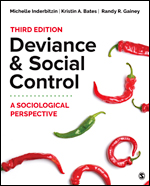Deviance and Social Control
A Sociological Perspective
Michelle Lee Inderbitzin - Oregon State University, USA
Kristin A. Bates - California State University, San Marcos, USA
Randy R. Gainey - Old Dominion University, Norfolk, USA
Included with this title:
The password-protected Instructor Resource Site (formally known as SAGE Edge) offers access to all text-specific resources, including a test bank and editable, chapter-specific PowerPoint® slides. Learn more.
Available formats
See what’s new to this edition by selecting the Features tab on this page. Should you need additional information or have questions regarding the HEOA information provided for this title, including what is new to this edition, please email sageheoa@sagepub.com. Please include your name, contact information, and the name of the title for which you would like more information. For information on the HEOA, please go to http://ed.gov/policy/highered/leg/hea08/index.html.
For assistance with your order: Please email us at textsales@sagepub.com or connect with your SAGE representative.
SAGE
2455 Teller Road
Thousand Oaks, CA 91320
www.sagepub.com
Instructor Resource Site
edge.sagepub.com/inderbitzin3e
Online resources included with this text
The online resources for your text are available via the password-protected Instructor Resource Site, which offers access to all text-specific resources, including a test bank and editable, chapter-specific PowerPoint® slides.
- Readings are updated to offer coverage of emerging issues such as the use of social media, misogyny in rap music, terrorism, segregation, immigration, and women's movements.
- Global examples are integrated into every chapter, exposing students to international perspectives while they are learning the substantive material.
- Key theoretical concepts are expanded, with new discussions of social constructionist conception, the looking-glass self, multicultural feminism, social control of mental illness, and restorative justice.
- The new edition explores the influence of the internet on deviance and subcultures and emerging topics such as the use of smartphones and social media, stigma management in the internet age, the #MeToo movement, and the effect of platforms like YouTube.
- Updated data reflect recent trends and events, including the Trump Administration’s stance on transgender individuals serving in the military, The Unslut Project, and the Black Lives Matter movement.
- Important topics impacting society and students such as human trafficking, school shootings, and world energy consumption rates are now included.
- Introductory vignettes from each chapter are updated to provide a strong starting point for each theory and topic.
KEY FEATURES:
- A unique text/reader format combines substantial original chapters that clearly explain and outline the sociological perspectives on deviance with carefully selected articles from leading academic sources.
- Deviance in Popular Culture boxes offer examples of deviance in social media, films, and television shows and encourage students to apply the concepts and theories they've learned about the behavior depicted.
- Deviance and Disparity sections explore the impact of status and inequality on different types of deviance and the reactions to such behavior
- Ideas in Action sections highlight examples of current policies or programs designed to address deviant behaviors from the perspective(s) covered in each chapter.
- Now You boxes ask students to apply the material they learned in the chapter to specific questions or examples.
- Global Perspectives on Deviance sections illustrate the wide range of deviance by covering examples of research, policies, and practices from around the world.
- The foreword to the book, written by renowned deviance scholar Howard S. Becker, provides an excellent foundation for the study of deviance.

